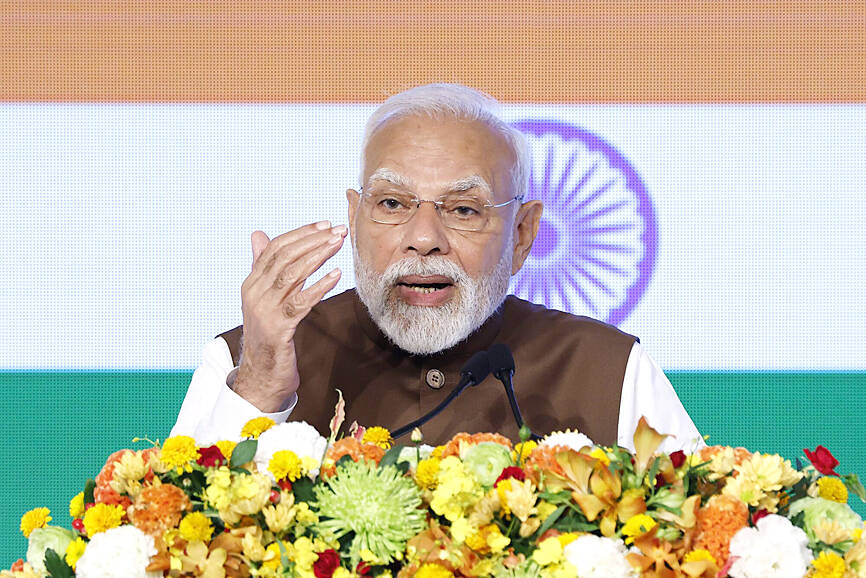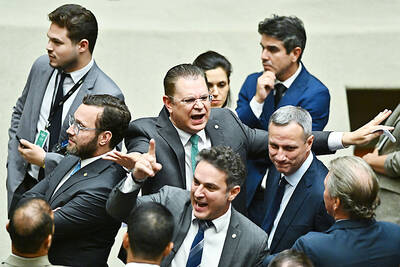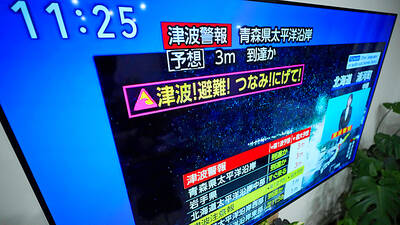Indian Prime Minister Narendra Modi is to land in China tomorrow for his first visit in seven years — a trip that puts him in the company of Chinese President Xi Jinping (習近平) and Russian President Vladimir Putin just as India’s ties with Washington have soured.
Modi’s visit to Tianjin for a regional security summit comes days after the US doubled tariffs on Indian exports to 50 percent, citing New Delhi’s refusal to stop buying Russian oil.
The row has upended years of deepening cooperation between India and the US, built on technology and a shared determination to counter Beijing’s global ambitions. It has also forced India to aggressively look elsewhere to diversify its trade.

Photo: Bloomberg
“Indian trust in the US is shattered,” South Asia analyst Michael Kugelman said. “I’m not sure whether US officials fully realize how much trust they have squandered in such a short time.”
BEIJING REVELING
For China, the two-day Shanghai Cooperation Organization summit that starts tomorrow could not be better timed.
Modi “will be in China at a moment when India-China relations are stabilizing and India-US relations have gone south. It is a powerful optic,” Kugelman said.
“No doubt there are some in China who are reveling in the trade tensions between India and the US,” said Manoj Kewalramani, head of Indo-Pacific studies at the Takshashila Institution in Bengaluru.
Putin would want to “capitalize on the moment by reasserting Russia’s close relationship with India,” Kugelman said, adding that it would be “a great moment for everyone to stick out their tongues at Washington.”
Washington has pointed to India’s continuing purchases of Russian crude oil and defense hardware as the reason for the tariff hike, saying that Delhi is helping fund Moscow’s war on Ukraine.
The economic blow is immense. The US is India’s biggest export market at US$86.5 billion a year, and two-thirds of that — about US$60.2 billion in goods — is now subject to the new duties, hitting labor-intensive sectors from textiles to jewelry.
Even before the tariffs, India had been cautiously warming to China as a source of investment and technology and in hopes of boosting trade.
Relations froze after a deadly clash along their disputed Himalayan border in 2020, but began to thaw when Modi and Xi met in person for the first time in four years at a BRICS summit in Russia in October last year.
Now, “the US-India crisis has given Modi good cause to accelerate efforts to ease tensions,” Kugelman said.
‘PRACTICAL GAINS’
Modi is expected to meet Xi on the sidelines of the regional summit, with trade and investment high on the agenda.
“An effort is under way to see if India and China can reach some sort of new equilibrium,” Kewalramani said. “Both recognize that the world order is in flux. Neither is likely to decisively manage all the frictions, but there’s at least a process of trying to grow the relationship.
“Historical mistrust will remain,” he said, pointing to their contested frontier that China continues to reinforce with new roads, railways and settlements, “but if Delhi and Beijing can create a measure of stability and predictability, without expecting structural breakthroughs, there are practical gains to be had.”
RUSSIA
India’s rift with the US also stands to benefit Russia, with Delhi seeing the relationship as more vital than ever for balancing ties with the West, diversifying military hardware purchases and ensuring energy security.
For Modi, the photos of him standing alongside Xi and Putin at the summit “will send a pointed message to Washington,” a retired Indian diplomat said.
Indian officials stress Delhi wishes to continue its ties with the US, but also needs to “diversify its partnerships.” India now cannot “afford to appear as though it is giving in to US pressure on oil imports, or anything else that could be construed as a capitulation — and public anger is high,” another official said on condition of anonymity.
On Thursday, the Indian government fired its first shot to offset the US tariffs, rolling out an export drive across 40 countries from the UK to South Korea to boost its textile trade.
Additional reporting by Reuters

PARLIAMENT CHAOS: Police forcibly removed Brazilian Deputy Glauber Braga after he called the legislation part of a ‘coup offensive’ and occupied the speaker’s chair Brazil’s lower house of Congress early yesterday approved a bill that could slash former Brazilian president Jair Bolsonaro’s prison sentence for plotting a coup, after efforts by a lawmaker to disrupt the proceedings sparked chaos in parliament. Bolsonaro has been serving a 27-year term since last month after his conviction for a scheme to stop Brazilian President Luiz Inacio Lula da Silva from taking office after the 2022 election. Lawmakers had been discussing a bill that would significantly reduce sentences for several crimes, including attempting a coup d’etat — opening up the prospect that Bolsonaro, 70, could have his sentence cut to

A plan by Switzerland’s right-wing People’s Party to cap the population at 10 million has the backing of almost half the country, according to a poll before an expected vote next year. The party, which has long campaigned against immigration, argues that too-fast population growth is overwhelming housing, transport and public services. The level of support comes despite the government urging voters to reject it, warning that strict curbs would damage the economy and prosperity, as Swiss companies depend on foreign workers. The poll by newspaper group Tamedia/20 Minuten and released yesterday showed that 48 percent of the population plan to vote

A powerful magnitude 7.6 earthquake shook Japan’s northeast region late on Monday, prompting tsunami warnings and orders for residents to evacuate. A tsunami as high as three metres (10 feet) could hit Japan’s northeastern coast after an earthquake with an estimated magnitude of 7.6 occurred offshore at 11:15 p.m. (1415 GMT), the Japan Meteorological Agency (JMA) said. Tsunami warnings were issued for the prefectures of Hokkaido, Aomori and Iwate, and a tsunami of 40cm had been observed at Aomori’s Mutsu Ogawara and Hokkaido’s Urakawa ports before midnight, JMA said. The epicentre of the quake was 80 km (50 miles) off the coast of

Brazilian Senator Flavio Bolsonaro on Friday said that his father, jailed former Brazilian president Jair Bolsonaro, has chosen him to lead the country’s powerful conservative movement, shaking up next year’s election race. The 44-year-old senator said on social media that he will carry forward the political legacy that reshaped Brazilian politics. His announcement makes him an instant contender for the presidency. Jair Bolsonaro, 70, is unlikely to run after being sentenced to 27 years for plotting a coup and banned from public office. He is appealing and seeking a legislative pardon. The former president also faces serious health issues, including complications from a